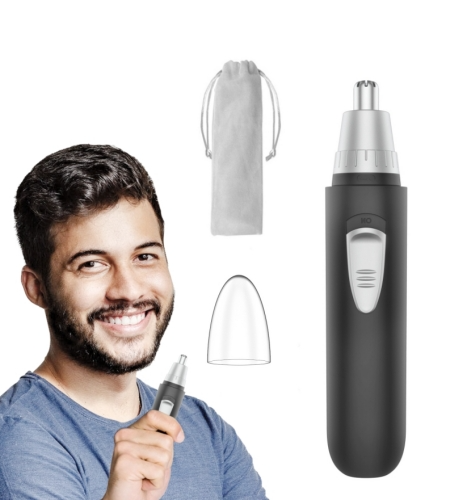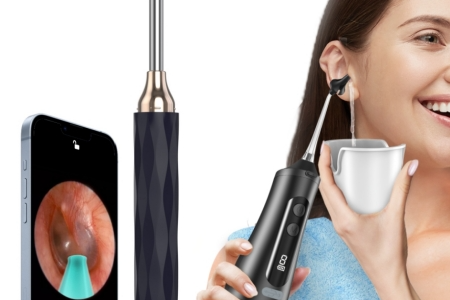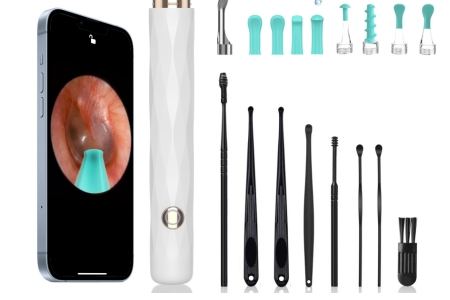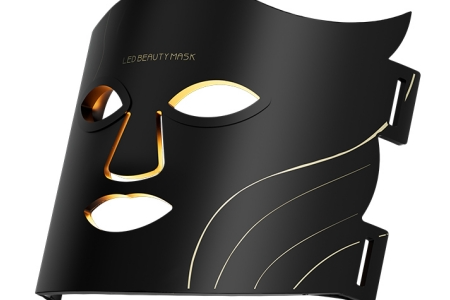
Dans le domaine des soins personnels et de la santé, Mlikang est fier d'offrir des produits innovants qui répondent à votre bien-être. Parmi ceux-ci, le tondeuse à poils de nez Mlikang se distingue comme un outil de toilettage essentiel qui favorise l'hygiène et maintient une apparence soignée.
La tondeuse à poils de nez Mlikang n'est pas qu'une simple tondeuse ; c'est une extension de votre mode de vie soucieux de votre santé. Avec son mécanisme de coupe précis et doux, elle garantit que les poils de nez inesthétiques sont maîtrisés, ce qui est crucial pour maintenir une bonne santé respiratoire. Cet appareil est particulièrement bénéfique pour les utilisateurs de nos inhalateurs d'hydrogène, qui apprécient la propreté et trouvent que cette tondeuse est un accessoire inestimable dans leur routine de bien-être.

Il ne fait aucun doute que Mlikang est un nom associé à la qualité et à la fiabilité en ce qui concerne les produits de soins personnels. En se concentrant sur les irrigateurs buccaux, les brosses à dents électriques, les appareils de beauté et d'autres articles de soins personnels ; Mlikang s'est positionné parmi les entreprises leaders dans ce segment de marché. En travaillant avec des centaines d'entreprises nationales et internationales sous des services OEM/ODM, Mlikang a acquis une vaste connaissance au-delà des limites ordinaires.
Dans la fabrication de tondeuses à poils de nez, chaque étape du processus de production de Mlikang montre leur compétence supérieure et leur attention aux détails par rapport à d'autres fabricants. Avec le confort et la commodité de l'utilisateur au cœur de la phase de conception, Mlikang s'assure que leurs tondeuses à poils de nez fonctionnent sans aucun problème ni tracas. De plus, ces tondeuses à la pointe de la technologie utilisent des technologies actuelles qui garantissent des coupes précises, ce qui les rend les plus préférées par les clients qui considèrent la qualité au même titre que la performance.

Ce n'est pas juste un outil de toilettage ; c'est une déclaration sur la façon dont les soins personnels peuvent être raffinés en utilisant cet appareil de Mlikang. Cet appareil est meilleur que les autres appareils car il a été créé avec les meilleurs matériaux disponibles et conçu de manière ergonomique. Pour les entreprises qui visent à offrir à leurs clients des expériences de premier ordre, nous leur proposons nos services ODM sans couture qui permettront d'améliorer leurs lignes de produits, augmentant ainsi la valeur de leur marque plus que jamais auparavant. En tant que fournisseur de services de Fabrication de Design Original, nous reconnaissons que chaque entreprise a des besoins uniques ; par conséquent, nous personnalisons tous nos produits, y compris ce coupe-brosse de narine, pour répondre à ces besoins tout en reflétant l'identité de ces organisations.
La fonctionnalité et la sécurité sont des considérations importantes lors de la conception de tout produit comme les ciseaux à poils de narine Mlikang – ces caractéristiques ont également été prises en compte lors de sa fabrication ! Dans cet esprit, des systèmes de coupe avancés permettent des tailles rapides et indolores tandis que des lames plus fines garantissent qu'aucun tirage ou irritation ne se produise pendant l'utilisation, vous permettant de vous détendre en sachant que tout se déroulera sans accroc du début à la fin. Nous avons travaillé en tant que fournisseurs OEM pour des centaines et des centaines d'entreprises au fil du temps, ce qui signifie qu'il ne devrait jamais y avoir de question concernant la fiabilité ou la cohérence en ce qui concerne les niveaux de performance, parmi d'autres choses directement liées à leur utilisation dans le cadre d'une stratégie de fidélisation des clients visant à s'assurer que chaque article produit respecte des contrôles de qualité stricts établis non seulement par nous mais aussi par des organismes reconnus internationalement comme l'ISO9001, qui vise toujours à satisfaire les besoins des clients au-delà de leurs attentes.

Les brosses à dents sont de plus en plus liées à l'électricité de nos jours. Une brosse à dents confortable et efficace est nécessaire pour de nombreuses chaises de bureau. C'est pourquoi les fabricants de brosses à dents électriques conçus spécifiquement pour ce domaine doivent être pris en considération. Parmi les fabricants de brosses à dents électriques recommandés, Mlikang a fourni des brosses à dents de haute qualité et d'autres produits de soins personnels à ses clients en tant que fabricant de brosses à dents électriques de premier plan. Nous sommes des experts en développement de brosses à dents électriques ; par conséquent, nous vous assurons que toutes nos brosses répondent à vos besoins en matière de performance, de confort et de commodité sans faille. La raison en est qu'elles ont été conçues pour être confortables et efficaces afin que les gens puissent maintenir une bouche propre facilement avec leur aide, mais aussi une bouche saine, ce que nous croyons fermement faire également. De plus, la commodité a dû être prise en compte, en plus de pouvoir régler facilement le minuteur des dents, que l'on préfère une utilisation unique ou jetable. Mlikang propose de nombreuses options disponibles, et le respect de l'environnement était une autre considération clé lors de la conception de ce type de brosse, d'où l'utilisation de matériaux écologiques. Nous restons très engagés à réduire notre empreinte carbone, même si cela doit être fait. Si vous souhaitez en savoir plus sur ce à quoi vous attendre des brosses électriques destinées à être utilisées tout en étant assis à nos bureaux, alors mon conseil serait toujours de recommander la société Mlikang, car je pense non seulement qu'elle servira bien, mais aussi qu'elle jouera un rôle dans la conservation de l'environnement.

Parmi les marques de soins personnels, Mlikang se caractérise par son élégance et cela se voit à travers sa large gamme de produits. Nos tondeuses à poils de nez ne sont pas de simples gadgets ; elles représentent notre engagement à rendre le toilettage personnel plus raffiné et fonctionnel. Alors, pourquoi quelqu'un devrait-il inclure une tondeuse à poils de nez Mlikang dans sa routine de beauté quotidienne pour la précision ainsi que le confort ?
Le design de la tondeuse à poils de nez Mlikang a été construit sur une base de savoir-faire technique. Nous nous sommes concentrés sur la création d'un article qui éliminera tous ces poils indésirables à l'intérieur de vos narines sans causer de douleur ou d'inconfort à l'utilisateur. Notre tondeuse utilise une technologie moderne qui garantit des coupes nettes sans irriter votre peau – cette caractéristique à elle seule nous distingue des autres marques disponibles dans les magasins aujourd'hui, puisque nous nous spécialisons dans les dispositifs de beauté en plus des produits de soins personnels, il était donc naturel que nous veillons à ce que nos partenaires OEM/ODM internationaux reçoivent rien de moins que la meilleure qualité.

Shenzhen Mlikang Technology Co., Ltd. a été établie en 2014, 10 ans dans l'industrie des soins personnels. Spécialisée dans les irrigateurs buccaux, les brossettes électriques, les appareils de beauté et les produits de soins personnels. OEM / ODM pour des centaines d'entreprises à l'étranger et au pays ; Nous avons notre propre département technique et laboratoire d'essai, ainsi qu'une technologie professionnelle et une expérience pratique de R & D et de production. Nous avons obtenu plus de 60 brevets de technologie et de design de beauté. Nous sommes une entreprise de haute technologie à Shenzhen. Nous disposons de bureaux de 300 mètres carrés et d'usines de plus de 1400 mètres carrés. Nos affaires se sont étendues aux États-Unis, en Europe, en Afrique du Sud, au Brésil, en Russie, en Corée du Sud et dans le monde entier. Nos produits d'irrigateur dentaire comprennent plus de dix conceptions créatives telles que la balle de gravité, une pression d'eau plus élevée, une conception de tampon à ressort et une conception imperméable indépendante.
Client d'abord, Qualité d'abord, Créer de la valeur ensemble
Fabriquer des produits de soins personnels avec l'expérience utilisateur ultime et créer de la valeur pour les clients ! Aider les employés à réaliser leur rêve d'avoir une voiture et une maison, et grandir ensemble avec les partenaires !
Dans dix ans, Mlikang est devenu une entreprise renommée dans l'industrie mondiale des soins buccaux !
Actif, Positif, Responsable, Honnête, Efficace, Altruiste

29
Apr
29
Apr
29
AprUn tondeuse à poils de nez est un petit appareil électronique conçu pour couper ou enlever les poils indésirables des narines ou de la zone nasale.
Les tondeuses à poils de nez ont généralement de petites lames rotatives qui coupent ou taillent en toute sécurité les poils de nez lorsque l'appareil est doucement inséré dans les narines.
Lorsqu'elles sont utilisées correctement, les tondeuses à poils de nez ne devraient pas causer de douleur. Il est important de suivre les instructions, de tenir la tondeuse doucement et d'éviter de l'insérer trop loin dans les narines.
Les tondeuses à poils de nez peuvent être utilisées par les hommes et les femmes pour tailler les poils de nez indésirables. Le design et la fonctionnalité conviennent aux individus de différents genres.
